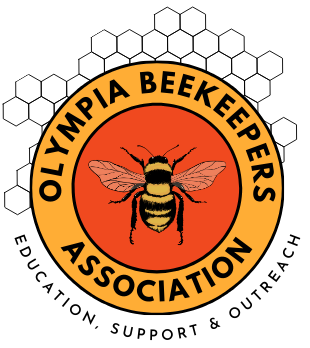Early Summer Bee Flowers
Pale Purple Coneflower (Echinacea pallida, perennial):
An elegant beauty with fine, drooping petals, the pale purple coneflower is a bee favorite that also produces seeds much loved by finches. A native of grasslands and savannahs across the Eastern United States, this tough coneflower will bloom for up to three weeks from June to July. When in bloom, its flowers will feed lots of bees. You might even see a few butterflies on them as well.

Common yarrow (Achillea millefolium, perennial):
The bright, flattened heads of common yarrow are covered with tiny daisy flowers that bees really favor. Native to both Eurasia and North America, this plant attracts loads of pollinators no matter where it’s planted. There are many beautiful varieties for the garden; two of the better variants are the rich red ‘Strawberry Seduction’ (image left) and ‘Wonderful Wampee’, which has pink flowers that fade to nearly white.
Pale Purple Coneflower (Echinacea pallida, perennial)
Common yarrow (Achillea millefolium, perennial)

Summer Bee Flowers
Sunflowers (Helianthus annuus, annual):
Nothing attracts and feeds bees like good old sunflowers. Their massive and prolific blooms come in shades of yellow, gold, red and orange and give way to lots of oil-rich seeds enjoyed by seed-eating birds and humans alike. There are literally hundreds of varieties to choose with various flower colors, heights and flower sizes. The dwarf varieties ‘Little Becka‘ (image left; 3-4’ tall with gold and brown flowers) and ‘Big Smile’ (1-2′ tall with classic golden flowers with black centers) are choice selections for any garden.

Blue Giant Hyssop (Agastache foeniculum, perennial):
The pretty spires of purple flowers produced by the giant hyssop become simply covered with bees. A native across the northern regions of North America, this fragrant perennial in the mint family it tough and very hardy. The hybrid Agastache ‘Blue Boa’ (image left by Terra Nova Nurseries) is an exceptional variety from Terra Nova Nursery that is exceptionally beautiful.

Horsemint (Monarda punctata, perennial):
Few garden perennials draw bees as efficiently as the long-blooming horsemint. A native of much of the United States, this sun-lover produces tiers of unique pink to white bracted flowers through much of summer and into fall. The blooms of these fragrant plants last a long time and become completely covered with pollinators. Plant in very well-drained soil for best performance.

Purple Coneflower (Echinacea purpurea, perennial):
The popularity of purple coneflowers and their many hybrids serves as a testament to their beauty and resilience. All are a favorite of bees, and like the pale purple coneflower, seed-eating birds enjoy the seedheads that follow. The purple-pink daisy flowers begin blooming in summer and will easily continue into late summer and even fall if the old flowers are removed. Some of the better new variants for big, long-blooming flowers include ‘Dixie Belle’ (left, image by Terra Nova Nurseries) and the super heavy blooming ‘Pica Bella’

Black-eyed Susan (Rudbeckia spp., annual or perennial):
Nothing says summer like a beautiful black-eyed Susan, and bees appreciate their prolific flowers just as much as we do. One to seek out is the heavy blooming dwarf ‘Little Goldstar’ (Rudbeckia fulgida var. sullivantii ‘Little Goldstar’).
Sunflowers (Helianthus annuus, annual)
Blue Giant Hyssop (Agastache foeniculum, perennial)
Horsemint (Monarda punctata, perennial)
Purple Coneflower (Echinacea purpurea, perennial):
Black-eyed Susan (Rudbeckia spp., annual or perennial

Late-Summer and Fall Bee Flowers
Asters (Symphotrichum spp., perennial):
The pinks, blues and purples of late-summer and fall aster flowers are a delight to all bees. There are so many wonderful varieties to choose from it’s hard to know where to start. The classic ‘October Skies’ (image left, Symphyotrichum oblongifolium ‘October Skies’) is a wonderful late bloomer with lavender-blue flowers and orange centers, and the dusty sky blue ‘Bluebird’ (Symphyotrichum laeve ‘Bluebird’) is an earlier bloomer with prolific flowers.

Joe-Pye Weeds (Eutrochium spp., perennial):
This group of mid-to late-summer bloomers produces big, fuzzy heads of purplish-red flowers filled with nectar and pollen. Native across North America, many of the sun-loving perennials are adapted to moist ground. One of the finest garden varieties is Eutrochium purpureum ‘Little Red’ with its 4′ tall stature and pretty reddish-purple flowers.

Goldenrods (Solidago spp., perennial):
Lauded as one of the best bee flowers for late summer and fall, goldenrods become a buzzing mass when they open. In fact, goldenrod honey is a delicacy, known to be darker with a distinctive bite. Excellent garden-worthy goldenrods include the dwarf forms ‘Golden Fleece’ (Solidago sphacelata ‘Golden Fleece’) and ‘Baby Gold’ (Solidago ‘Baby Gold’).
Asters (Symphotrichum spp., perennial)
Joe-Pye Weeds (Eutrochium spp., perennial)
Goldenrods (Solidago spp., perennial)

